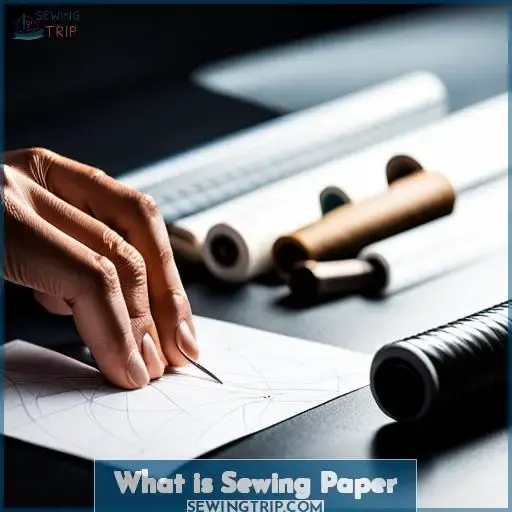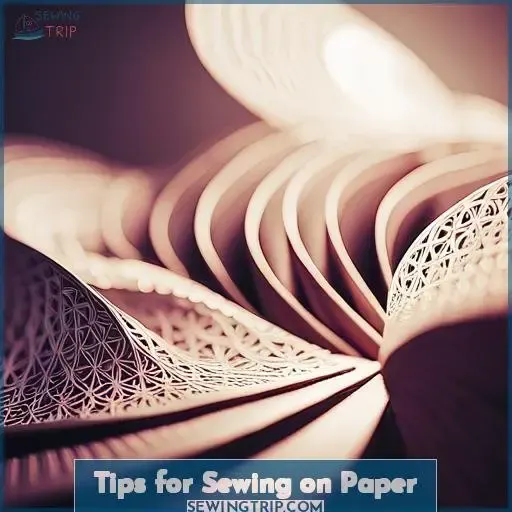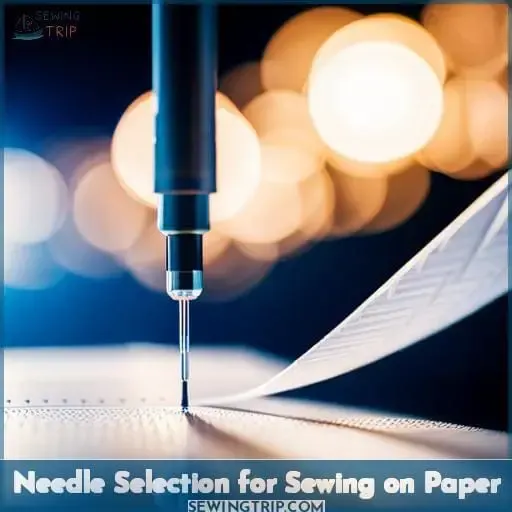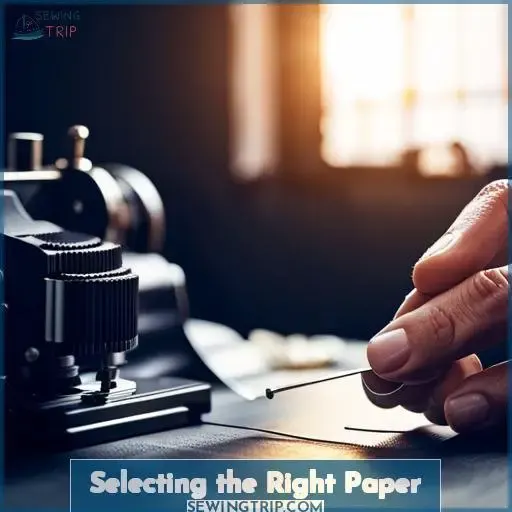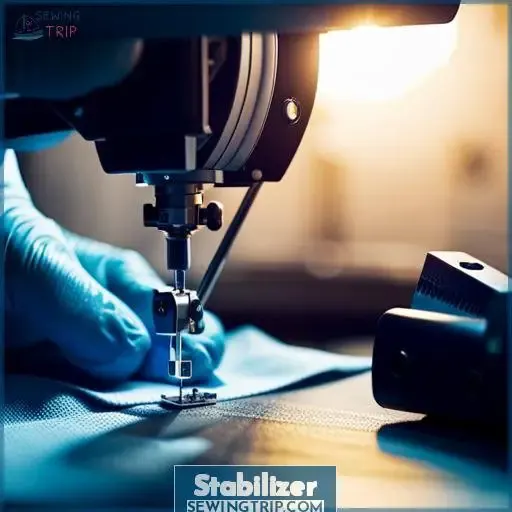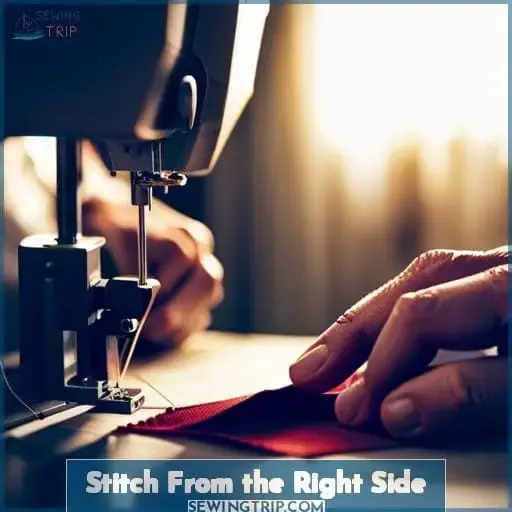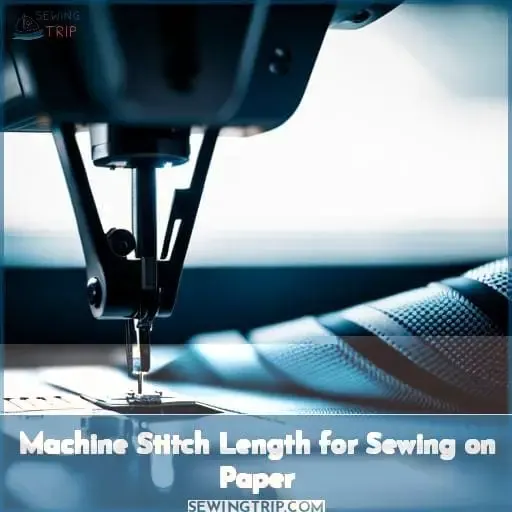This site is supported by our readers. We may earn a commission, at no cost to you, if you purchase through links.
Sewing paper is the perfect way to add a unique, creative touch to your crafts and projects. It can be used in a variety of ways – from embellishing greeting cards, creating treat bags, or making personalized embroidery designs.
But before you pick up that needle and thread, there are some important details you need to know! With the right supplies and techniques, hand sewing on paper can give beautiful results for any project – but it does take practice!
So if you’re ready to get started with this fun craft activity, read on for tips about selecting needles and papers as well as best practices when stitching by machine or by hand.
Table Of Contents
- Key Takeaways
- Tips for Sewing on Paper
- Best Paper Sewing Craft Ideas
- Needle Selection for Sewing on Paper
- Selecting the Right Paper
- Stabilizer
- Take Your Time
- Stitch From the Right Side
- Do Not Use Pins
- Machine Stitch Length for Sewing on Paper
- Cleaning Your Sewing Machine After Sewing on Paper
- Frequently Asked Questions (FAQs)
- Conclusion
Key Takeaways
- Sewing on paper adds a unique touch to crafts and projects.
- Choosing the right needle and adding stabilizer is important for both hand and machine sewing on paper.
- Basic embroidery stitches like running stitch, backstitch, satin stitch, and blanket stitch work well on paper.
- Experimenting with different types of paper and threads can yield beautiful results.
Tips for Sewing on Paper
Sewing on paper is a great way to add an extra touch of creativity and personalization to any project. You can easily learn how to do it using either a sewing machine or by hand. With the right supplies, tips, and techniques, you’ll soon be crafting amazing projects with unique designs that will stand out from the rest! To get started, read on for helpful advice about sewing paper both with a machine or by hand.
With a Sewing Machine
Using a sewing machine to sew on paper requires special considerations, so take the time to properly plan your project before you begin. Choose an appropriate needle, such as Jeans or Topstitch, for best results. Use fusible stiffening paper and cutaway stabilizer behind stitching if needed for reinforcement.
Select embroidery designs without too many fill stitches and try out different weights of watercolor-painted paper, like cardstock or construction papers, with basic stitches like running stitch, backstitch, satin stitch, etc.
By Hand
Take a gentle approach to your paper crafting and get creative with hand-stitching! When sewing on paper by hand, choose the right needle for the size of the hole you want. Use larger stitches and reinforce thin or delicate papers with pre-punched holes or muslin cloth.
Experiment with different types of paper, such as cardstock or handmade papers. Have fun creating unique designs like dictionary art using basic embroidery stitches that work best on paper, like running stitch, backstitch, satin stitch, and blanket stitch.
Best Paper Sewing Craft Ideas
Are you searching for creative and enjoyable ideas to craft with paper? Sewing paper can be an excellent way to create unique crafts that stand out from the rest. Give Paper Embroidery, Dictionary Art, DIY Beautiful Book Page Bags Crafts, Stitched Journal Cards, and Threaded Heart Decor a try.
Paper Embroidery and How to Make Dictionary Art
Discover how to create stunning dictionary art with paper embroidery! Making stitches on paper is an easy way to add texture, color, and interest. To start, select a heavy-duty needle that works for the type of paper you’re using, as well as a stabilizer.
Step-by-step tutorials are available online to learn the main ways: tracing onto tissue or transfer paper and then machine stitching it, hand sewing directly onto thin book pages or photographs, or creating appliqué shapes from fabric which are then stitched down with your machine’s settings.
DIY Beautiful Book Page Bags Craft
Create something beautiful and unique with book page bags – a perfect way to upcycle old books into a fun craft! Use your own paper-stitched embroideries or embroidery designs to add interest. Experiment with different paper types, such as vintage pages or cardstock, and incorporate variegated thread for added color.
Adjust machine settings and avoid fill stitches for the best results on delicate papers.
Stitched Journal Cards
Bring your creativity to life with stitched journal cards! Embroidery techniques, such as running, backstitches, and satin, are great for adding decorative embellishments. Choose the right thread selection that works best with the paper type you have selected.
You can create lovely dotted patterns or intricate designs by using a pre-punched hole method on thin paper-like book pages too! Embroidery companies offer collections made specifically for stitching on greeting cards, which allows you to express yourself in creative ways.
Reinforce thin papers with muslin cloth so they don’t tear during embroidery and choose thicker cardstock if sewing machines are involved.
With these tips, you can create beautiful masterpieces that will surely wow everyone who sets eyes upon them!
How to Make Stitched Paper Christmas Cards
Make a festive statement this holiday season with stitched paper Christmas cards! Choose your favorite cardstock, then create the template you want to stitch. Invest in a sharp needle and choose thread that will stand out against the paper color.
Use fusible stabilizer as an extra layer of support while stitching slowly and carefully.
For best results, use longer stitches than usual when sewing on paper. Cut threads after each pattern piece is complete.
With these useful techniques at hand, let’s get creative making unique Christmas cards this year!
Threaded Heart Decor
You can add a touch of love to your holiday decorations by threading together some pretty paper hearts! Choose embroidery designs with variegated thread, pre-punch holes, or strengthen the paper with fusible stiffening.
Sewing clips and tear-away stabilizer will help prevent tearing as you sew stitches through the paper. Using simple stitches and not pulling too hard, secure threads at the back with knots or glue for an extra special finishing touch.
Make Greeting Cards With Your Embroidery Machine
Create beautiful and unique greeting cards with your embroidery machine to impress family and friends! Embroidery designs are perfect for adding eye-catching details to any project. To get the best results, choose the right paper weight, experiment with variegated thread colors, use fusible stiffening on thin paper, and adjust machine settings.
Sewing machines make it fun to add decorative stitches that will stand out against plain cardstock or construction paper. For optimal results, remember to stitch from the right side of the paper. Making greeting cards is an easy craft that anyone can do.
Needle Selection for Sewing on Paper
Choose wisely! Your needle selection for sewing on paper will determine the overall look of your project and how successful it is. When hand-sewing, choose a sharp needle type such as Topstitch or Jeans to achieve holes that are small enough in diameter so they don’t tear the paper.
If you use thread that is thicker than necessary, make sure to pre-punch holes or strengthen the paper before stitching.
For machine embroidery designs on greeting cards or old photographs, try using Microtex needles with shorter stitch lengths for best results. Reinforcing thin book pages with muslin cloth allows for hand embroidery without tearing them apart.
Thicker papers work well when sewing on a machine because longer stitches can be taken without perforating the material itself too much.
Thread selection should also take into consideration what kind of effect you want your projects to have. Variegated threads add pops of color and interest, while solid colors allow details like journal cards and decorative stitching patterns to stand out more clearly against plain backgrounds.
Sewing success depends largely upon choosing both the right needles and the right threads based on one’s desired outcome.
Selecting the Right Paper
When selecting paper for sewing, you must consider the weight and texture to ensure your project turns out just right. You can use cardstock, construction paper, and handmade papers that are thicker than regular printer or copy paper.
For added support when hand embroidering thin book pages, muslin cloth or fusible stiffening can be used as a layer of reinforcement. Variegated thread adds an amazing pop of color to any fabric craft, while testing machine settings with a variety of stitches is necessary for best results on heavier projects like greeting cards.
When using these layers, it’s important to keep in mind that adding too much bulk may cause the needle to break or jam during stitching.
Finally, remember that every stitch taken makes permanent changes in your work. So sew carefully and enjoy creating unique designs with embroidery collections designed specifically for stitched paper crafting!
Stabilizer
Adding a layer of stabilizer behind the stitching ensures your paper won’t tear as you sew, so give it a try!
When selecting an embroidery design for paper crafting, look for one without tons of fill stitches and extra dimension. Variegated threads can add amazing color to any project, but use them with caution because they will show through on the other side.
Fusible stiffening is also useful when reinforcing thin book pages or adding muslin cloth to hold two pieces together securely.
To prevent perforation from occurring while sewing, make sure to set stitch length longer than the normal setting.
The Amazon Services LLC Associates Program offers helpful resources that are great starting points in successful stitched projects – check them out today!
Take Your Time
Transitioning from stabilizers to taking your time, sewing paper requires patience and precision. When working with paper, it is important to lengthen the stitches – longer than you would for fabric – as shorter stitches can cause perforation of the page.
Different needle types must also be chosen based on the weight of the paper being used; a Jeans or Topstitch needle works best for cardstock and construction papers while Microtex needles are better suited for lighter handmade papers.
To ensure successful results:
- Choose an appropriate length for each individual type of stitching option selected.
- Select embroidery designs without too many fill stitches so that they don’t tear through thinner sheets of tracing or other delicate papers used in sewing projects.
- Use a small dab of glue instead of pins when attaching two pieces together so that there isn’t any damage to either one during the stitching process.
Sewing on paper may seem daunting, but following these steps will give you great results every time! Experiment with different weights and textures until finding what works best depending on your project’s nature, then start creating masterpieces out of simple sheets full of art potentials! Don’t forget to use thread colors according to how creative ideas come up, giving life special touches projects require.
Stitch From the Right Side
Always stitch from the right side of your paper for best results. Whether you’re using a sewing machine or hand-sewing, it’s important to understand that each needle will create various sized holes in the paper.
Different types of paper also require different stitching techniques. Cardstock works well on a machine, while tracing papers need special stabilizers like tear-away or cutaway backed with muslin cloth for embroidery without tearing.
Furthermore, cleaning your machine after every use is essential to remove any lint and fuzz created by sewing on paper.
Experimenting with different weights such as construction paper or handmade ones gives you an array of options too. Just be mindful about pulling thread too hard because it can damage delicate materials easily.
Do Not Use Pins
When it comes to sewing paper, there are some key points to remember. First and foremost, pins should not be used when attaching two pieces of paper together. Instead, use clips or a small dab of glue. Furthermore, making stitches on paper requires careful needle selection for best results.
Opt for sharp needles like Jeans Topstitch or Microtex so as not to tear holes in the worksheet you’re working with.
Here are a few more tips:
- Experiment with different weights and types of papers – cardstock, construction paper, etc.
- Use basic mazes/dot-to-dot pictures to practice stitching skills.
- Opt for larger stitches if hand sewing.
- Choose variegated thread for an amazing pop of color.
- Add stabilizer behind stitching lines so they don’t rip through the sheet easily.
Sewing on Paper is quick and easy, and it can help kids learn how to stitch effectively too! With all these guidelines in mind, one can create unique greeting cards while mastering this fun crafty skill!
Machine Stitch Length for Sewing on Paper
Adjust the stitch length on your machine to longer than normal when sewing paper, so you don’t end up with perforations.
To get the best results from embroidery designs and stitches sewn onto paper, it is important to watch the paper rather than just focusing on your needle.
Fusible stiffening or tear-away or cutaway stabilizers can be used in combination with tracing paper for added reinforcement when hand stitching thin book pages.
Variegated thread adds an eye-catching pop of color and texture, making it a popular choice among cardmakers and junk journalers looking for decorative embellishments.
It is also essential that you choose a sharp needle such as Jeans, Topstitch, or Microtex needles if you want nice holes through your papers without tearing them apart while going through them multiple times with different stitches like running stitch, backstitch, etc.
Every stitch taken will create permanent holes in your work, so make sure to finish off by cutting thread at the backside before securing it either using knots or glue.
Cleaning Your Sewing Machine After Sewing on Paper
After adjusting your machine settings and needle selection for the perfect stitch length when sewing on paper, it’s important to clean your sewing machine after each use.
Sewing on paper can create a lot of lint, fuzz, and extra threads that must be removed from the bobbin case area as well as other areas inside the machine to ensure its longevity. To avoid damaging fabric substitutes such as tracing paper or embroidery designs in future projects, make sure all build-up has been removed before you start another project.
Start by removing any pieces of thread stuck around moving parts like feed dogs or presser feet with tweezers.
Finally, check if there are any loose screws which may affect stitches’ strength over time before putting everything back together again so you’re ready to go for the next project!
Frequently Asked Questions (FAQs)
What types of stitches work best on paper?
When sewing on paper, it’s important to choose the right stitches to achieve the desired texture and color. Basic embroidery stitches like running stitches, backstitches, satin or blanket stitch are ideal for this purpose.
It’s like painting by numbers! This method not only allows for creativity and fun, but also adds a level of sophistication to your work, making you feel like an expert in no time.
Are there any special tools needed for sewing on paper?
To sew on paper, you will need a sharp needle, thread, and paper clips. Experiment with various materials such as cardstock and construction paper to achieve creative results. Use embroidery designs sparingly to avoid tearing the page. Apply stabilizer to the backside of the project for reinforcement and consider using tear-away or cutaway stabilizers as well.
Remember to snip excess thread at the back and secure the knot or glue for finishing touches.
Is sewing on paper permanent?
Sewing on paper is indeed permanent as the holes created by the stitches cannot be undone. It is crucial to use the appropriate needle and stitch length when using a sewing machine on paper to achieve a professional look without perforating the paper.
Is it difficult to sew on paper?
Sewing on paper can be challenging, but with the right tools and techniques, it is doable. Choose a needle that suits your project, use the correct stitch length, and go slowly to avoid tearing or perforating the paper.
Are there any special techniques to follow when sewing on paper?
Yes, there are special techniques to follow when sewing on paper. It is important to use the correct needle and stitch length, go slowly, avoid using pins, and keep a close eye on the paper. When choosing paper for hand or machine sewing, it is important to select an appropriate type.
For hand-sewing, larger stitches may be necessary, and pre-punching of holes may be required.
Conclusion
Sewing on paper is an interesting and creative way to add texture and color to a project. It’s easy to get carried away and make something amazing with paper and thread. With the right tools and a little practice, you can use your creativity to make stunning paper crafts.
Whether you’re hand-sewing or using a machine, the process is surprisingly simple and rewarding. Try experimenting with different weights of paper, needles, and stabilizers to see what works best for your project.
With patience and a bit of creativity, you can make something that will be admired for years to come.

